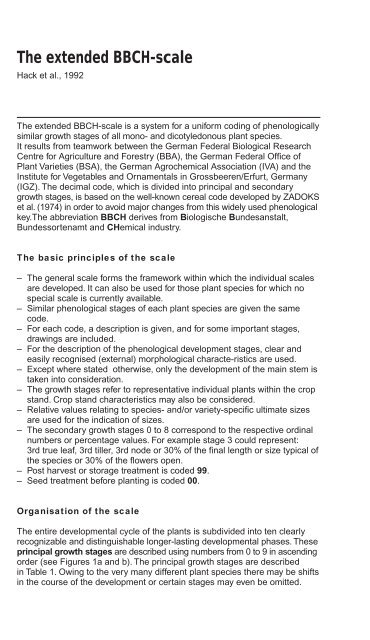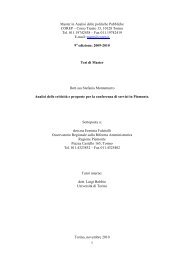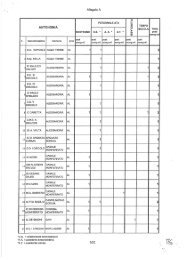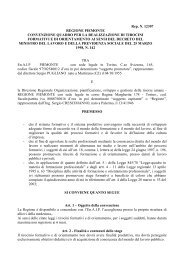Growth stages of mono-and dicotyledonous plants - Regione ...
Growth stages of mono-and dicotyledonous plants - Regione ...
Growth stages of mono-and dicotyledonous plants - Regione ...
Create successful ePaper yourself
Turn your PDF publications into a flip-book with our unique Google optimized e-Paper software.
The extended BBCH-scale<br />
Hack et al., 1992<br />
The extended BBCH-scale is a system for a uniform coding <strong>of</strong> phenologically<br />
similar growth <strong>stages</strong> <strong>of</strong> all <strong>mono</strong>- <strong>and</strong> <strong>dicotyledonous</strong> plant species.<br />
It results from teamwork between the German Federal Biological Research<br />
Centre for Agriculture <strong>and</strong> Forestry (BBA), the German Federal Office <strong>of</strong><br />
Plant Varieties (BSA), the German Agrochemical Association (IVA) <strong>and</strong> the<br />
Institute for Vegetables <strong>and</strong> Ornamentals in Grossbeeren/Erfurt, Germany<br />
(IGZ). The decimal code, which is divided into principal <strong>and</strong> secondary<br />
growth <strong>stages</strong>, is based on the well-known cereal code developed by ZADOKS<br />
et al. (1974) in order to avoid major changes from this widely used phenological<br />
key.The abbreviation BBCH derives from Biologische Bundesanstalt,<br />
Bundessortenamt <strong>and</strong> CHemical industry.<br />
The basic principles <strong>of</strong> the scale<br />
– The general scale forms the framework within which the individual scales<br />
are developed. It can also be used for those plant species for which no<br />
special scale is currently available.<br />
– Similar phenological <strong>stages</strong> <strong>of</strong> each plant species are given the same<br />
code.<br />
– For each code, a description is given, <strong>and</strong> for some important <strong>stages</strong>,<br />
drawings are included.<br />
– For the description <strong>of</strong> the phenological development <strong>stages</strong>, clear <strong>and</strong><br />
easily recognised (external) morphological characte-ristics are used.<br />
– Except where stated otherwise, only the development <strong>of</strong> the main stem is<br />
taken into consideration.<br />
– The growth <strong>stages</strong> refer to representative individual <strong>plants</strong> within the crop<br />
st<strong>and</strong>. Crop st<strong>and</strong> characteristics may also be considered.<br />
– Relative values relating to species- <strong>and</strong>/or variety-specific ultimate sizes<br />
are used for the indication <strong>of</strong> sizes.<br />
– The secondary growth <strong>stages</strong> 0 to 8 correspond to the respective ordinal<br />
numbers or percentage values. For example stage 3 could represent:<br />
3rd true leaf, 3rd tiller, 3rd node or 30% <strong>of</strong> the final length or size typical <strong>of</strong><br />
the species or 30% <strong>of</strong> the flowers open.<br />
– Post harvest or storage treatment is coded 99.<br />
– Seed treatment before planting is coded 00.<br />
Organisation <strong>of</strong> the scale<br />
The entire developmental cycle <strong>of</strong> the <strong>plants</strong> is subdivided into ten clearly<br />
recognizable <strong>and</strong> distinguishable longer-lasting developmental phases. These<br />
principal growth <strong>stages</strong> are described using numbers from 0 to 9 in ascending<br />
order (see Figures 1a <strong>and</strong> b). The principal growth <strong>stages</strong> are described<br />
in Table 1. Owing to the very many different plant species there may be shifts<br />
in the course <strong>of</strong> the development or certain <strong>stages</strong> may even be omitted.

















